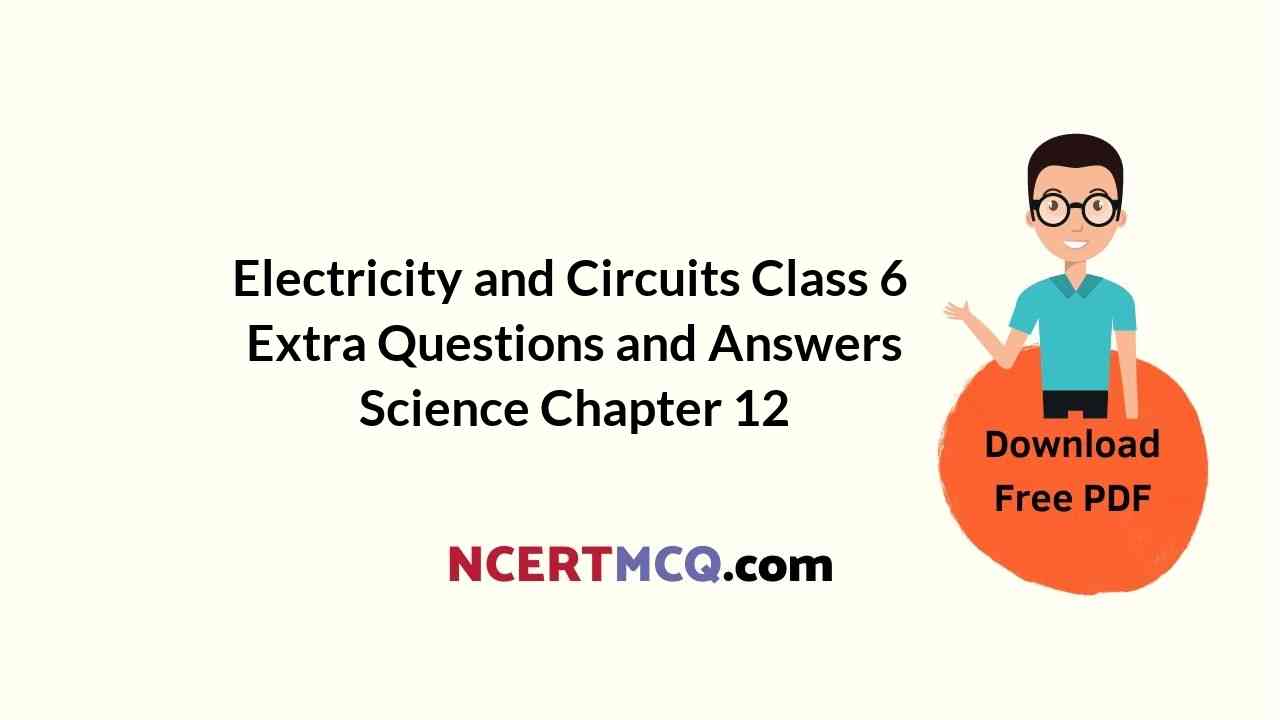In this page, we are providing Online Education for Electricity and Circuits Class 6 Extra Questions and Answers Science Chapter 12 pdf download. NCERT Extra Questions for Class 6 Science Chapter 12 Electricity and Circuits with Answers will help to score more marks in your CBSE Board Exams. https://ncertmcq.com/extra-questions-for-class-6-science/
Online Education for Class 6 Science Chapter 12 Extra Questions and Answers Electricity and Circuits
Extra Questions for Class 6 Science Chapter 12 Electricity and Circuits with Answers Solutions
Electricity and Circuits Class 6 Extra Questions Very Short Answer Type
Electricity And Circuits Class 6 Question 1.
Name a good conductor of electricity which is not a metal.
Answer:
Air
Electricity And Circuits Class 6 Extra Questions Question 2.
Name the material that glows inside the bulb.
Answer:
Filament
Class 6 Science Chapter 12 Extra Questions Question 3.
What kind of cells are used in TV remotes?
Answer:
Pencil cells
Electricity And Circuits Class 6 Questions Answers Question 5.
What is a cell?
Answer:
It is a device that produces electricity.
Electricity And Circuits Class 6 With Answers Question 6.
What is electricity?
Answer:
The flow of an electric current constitutes electricity.
Ncert Class 6 Science Chapter 12 Extra Questions Question 7.
How many terminals are there in a cell?
Answer:
There are two terminals in a cell.
Class 6 Electricity And Circuits Extra Questions Question 8.
What is the main function of a switch?
Answer:
It is used to regulate the flow of current in a circuit.
Class 6 Electricity And Circuits Question 9.
Name some metals which are conductors.
Answer:
Silver, copper, aluminium, etc.
Class 6 Science Ch 12 Extra Questions Question 10.
Name some conductors which are not metals.
Answer:
Moist air, salt solution, impure water, graphite, etc.
Extra Questions On Electricity And Circuits For Class 6 Question 11.
Name some insulators of electricity.
Answer:
Mica, ebonite, glass, wood, dry air, etc.
Class 6 Science Electricity And Circuits Extra Questions Question 12.
Which type of material is used in electric appliance as protective measures?
Answer:
Insulator
Class 6 Science Chapter 12 Extra Question Answer Question 13.
What is an open circuit?
Answer:
When there is a gap between two terminal, the circuit is called an open circuit.
Ncert Solutions For Class 6 Science Chapter 12 Extra Questions Question 14.
Can rubber or jute be used instead of metal wire to connect circuit?
Answer:
No, we cannot use rubber or jute to connect circuit wires.
Chapter 12 Class 6 Science Extra Questions Question 15.
How is electricity produced by an electric cell?
Answer:
An electric cell produces electricity from chemicals stored in it.
Question 16.
Name two metal used to connect wires.
Answer:
Copper and aluminium.
Question 17.
When does a bulb glow?
Answer:
A bulb glows only when the circuit is complete.
Question 18.
Why is tungsten used as a filament?
Answer:
Tungsten has high melting point and high resistance, hence it is used as filament.
Question 19.
Why are electric wire, covered with rubber and plastic?
Answer:
To prevent electric shocks as they are insulators.
Question 20.
In which of the following circuits A, B and C given below, the cell will be used up very rapidly?

Answer:
In circuit C the cell will be used up very rapidly because two bulbs are connected to a single cell.
Electricity and Circuits Class 6 Extra Questions Short Answer Type
Question 1.
Why we are advised not to touch electric appliances and switches with wet hands?
Answer:
Water is a good conductor of electricity and if our hands are wet it can pass to us quickly giving us an electric shock.
Question 2.
Define an electric cell and a battery.
Answer:
A cell is an electric device that produces electricity. When two or more cells are joined together, it is called a battery.
Question 3.
Define a conductor.
Answer:
The substance which allows an electric current to pass through it, is called a conductor, e.g., metals like gold, silver, etc.
Question 4.
What is an insulator?
Answer:
The substance which does not allow current to pass through it, is called an insulator, e.g., eraser, paper, polythene, etc.
Question 5.
What do you mean by an electric circuit?
Answer:
The closed path along which the electric current flows from one terminal to another is called as an electric circuit.
Question 6.
What is an open circuit? Does current flow in it?
Answer:
The circuit in which arrangements of components is disturbed any way or electric contact of any point is broken is called an open circuit. An electric current does not flow in an open circuit as the electrical path required for flow of current is not completed.
Question 7.
Why is a copper wire usually covered with rubber or plastic?
Answer:
Rubber or plastics are insulators. They prevent short circuiting and electric shocks if by mistake any living things come in contact with the wires.
Question 8.
Is air a conductor or an insulator? Explain.
Answer:
If air is dry then it is an insulator or bad conductor of electricity as it doesn’t conduct electricity when the circuit is open. If air is moist then it acts as conductor.
Question 9.
Why does a cell stop producing electricity after sometime?
Answer:
After sometime, all the chemicals in an electric cell is used up. Thus, no chemical reaction takes place to produce electrical energy.
Electricity and Circuits Class 6 Extra Questions Long Answer Type
Question 1.
What is bulb? Mention two main conditions necessary to make the bulb glow.
Answer:
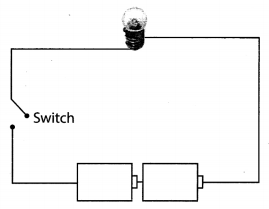
A bulb is an electric device which gives us light when a suitable material inside it called filament gets heated up to a high temperature. It runs on electricity viz., when an electric current passes through it, it glows.
Two main conditions necessary to make the bulb light up are:
(i) Connect the positive (+ve) terminal of the left cell with the negative (-ve) one of the right side cell using a wire.
(ii) Close the switch to complete the circuit.
Question 2.
Explain how does an electric current flow in an electric circuit.
Answer:
An electric current flows from the positive (+ve) terminal to the negative (-ve) terminal of the cell in the circuit through the connecting wires as shown in the given figure.
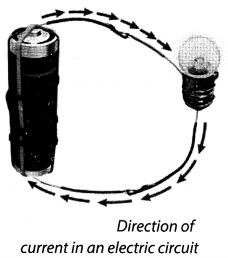
The current flows only when the circuit is complete, i.e., all the connections are intact and the key is switched ‘on’. We see that the bulb glows. But when the wires are broken or not properly connected to the terminals of the cell, the circuit is incomplete and the current does not flow in the circuit. The bulb does not light up.
Question 3.
What is torch? Give its various parts and explain its working. Also give its labelled diagram.
Answer:
A torch is an electric device that runs on electricity. It is actually a compact electric circuit. Its various parts are-a metallic or plastic casing, bulb, reflector, slide, switch, metal switch contact.
An electric current flows in a closed circuit only. In a torch, the cells are connected to a small bulb through a slide switch. When this slide switch is slided forward cell contact is complete with the bulb. The electric circuit is closed or complete.
The electric current starts flowing from the terminal of the cell and returns to the other terminal. Thus, the bulb starts glowing and gives light. On the other hand, on switching off, the contact between the metal strips is broken and the current stops flowing. Thus, the bulb stops glowing.
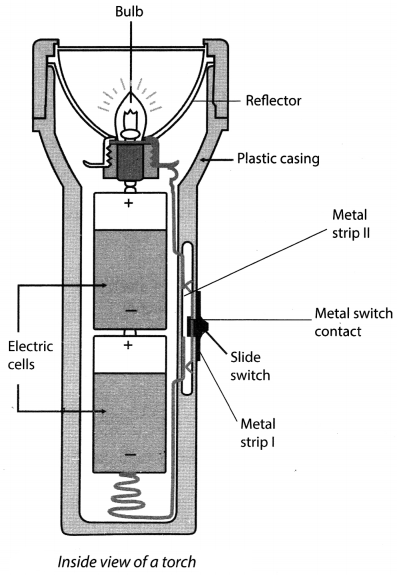
Question 4.
What is a circuit? Name its different components and draw a labelled diagram of a circuit.
Answer:

A circuit is a path along which an electric current flows. It is made up of various electrical components which are discussed below:
- There is a cell or a battery in the circuit that is used as a source of electric current.
- There is an electric switch that is used to regulate the flow of current. It is also called ‘key’. When the switch is ‘on’, the current flows in the circuit and when it is ‘off, the current does not flow.
- A bulb is connected to the circuit to confirm the flow of current. When it lights up, the circuit is said to be complete, i.e., current is flowing.
- On the other hand, when the bulb does not glow, the circuit is said to be incomplete, i.e., current is not flowing.
- The most important component of the circuit is the connecting wire which connect all the components of the circuit to make the current flow.
Question 5.
Describe a closed and open circuit with the help of diagrams.
Answer:
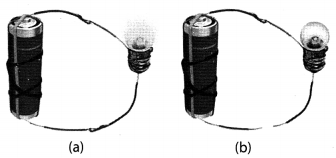
A circuit which is complete in all respect, i.e., its all connections are intact is called a closed circuit. When the switch is on, the current flows in it and the bulb glows (Fig. 12.22a). On the other hand, a circuit is called open or not complete (Fig. 12.22b), when connections are not intact, i.e., broken. In an open circuit, when the switch is on, the bulb does not glow. It means that current is not flowing in the circuit. This is due to broken wires or all components in the circuit are not connected properly.
Question 6.
Mention different safety measures and precautions while using electricity and electrical appliances.
Answer:
Electricity is very useful to us. It has made our life comfortable, easy and luxurious. On the other hand, it is dangerous also. It may cause great mishappenings, injuries and sometimes even death. So we must adopt some safety measures and take precautions discussed below:
- Never touch electrical switches or gadgets when your body is wet.
- If you need to operate or repair any electrical appliances, wear rubber hand gloves and stand on a dry wooden or plastic base.
- Never play with electric sockets or wires.
- In case of short circuit or a spark in a switch, put the main switch off immediately with the help of a plastic or wooden stick.
- In case of fire in electric wires, never use water to extinguish it. First switch off the mains, then use dry sand to extinguish the fire.
Electricity and Circuits Class 6 Extra Questions HOTS
Question 1.
Two bulbs are connected to a cell as shown in Fig. 12.23. Bulb A got fused. Will the bulb B glow in this circuit? Why?
Answer:
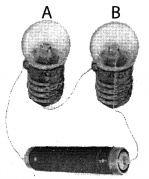
No, the bulb B will not glow because there is only one path from the source of current. If any one of the light bulbs get fused, the entire circuit will stop operating.
Question 2.
You have a single piece of connecting wire. Can you make a bulb glow without cutting the wire into two? Explain with the help of a circuit diagram.
Answer:
Yes, we can glow the bulb by joining one end of the wire to the negative terminal of battery and other to the metal cap of the bulb. Then by placing the bulb on the positive terminal of the cell will make the bulb glow.

Question 3.
which of the labels 1, 2, 3, 4 or 5, shows the terminals of the bulb?
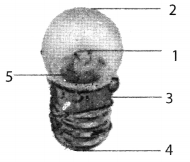
Answer:
Label 3 and 4 shows the terminals of the bulb.
Question 4.
Two different ways are shown below to connect a bulb with a cell.
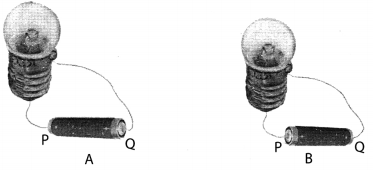
(i) What will be the direction of the current through the bulb in both the cases. (Q to P or P to Q)
(ii) In which case the bulb will glow?
(iii) Does the brightness of the glowing bulb depend on the direction of current through it?
Answer:
(i) In Fig. A, current will flow from Q to P and in Fig. B current will flow from P to Q.
(ii) In both of the cases bulb will glow as the circuit is complete.
(iii) No.
Electricity and Circuits Class 6 Extra Questions Value-Based (VBQs)
Question 1.
When Sheena’s classmates leave for games, library, yoga, etc., classes, Sheena always remembers to switch off the lights and fans of her class. For this practice she was honoured by the president of eco-club.
(a) What is electricity?
(b) What are the sources of electricity in your home?
(c) What values of Sheena is shown here?
Answer:
(a) Electricity is a form of energy used to power machines and electrical appliances.
(b) We get electricity in our home through cell, power house and solar cells.
(c) Sheena is an eco-friendly, responsible and intelligent girl.
Question 2.
After taking a bath Rahman went to his room. As soon as he raised his hand to switch on the light, his mother shouted out loudly. He was very astonished, with the strange behaviour of his mother. His mother came to him and explained him the reason “why he shouldn’t be touching the electrical items with wet hands”. Rahman made up his mind to spread this awareness in the school. So he decided to give a small speech on this topic during the school assembly.
(a) What are electrical appliances?
(b) What would have happened if Rahman touched the switch with his wet hand?
(c) What value of Rahman is shown here?
Answer:
(a) Devices that run on electricity are called electrical appliances.
(b) He might have got shock.
(c) Rahman is a responsible, sensible, caring and confident boy.
